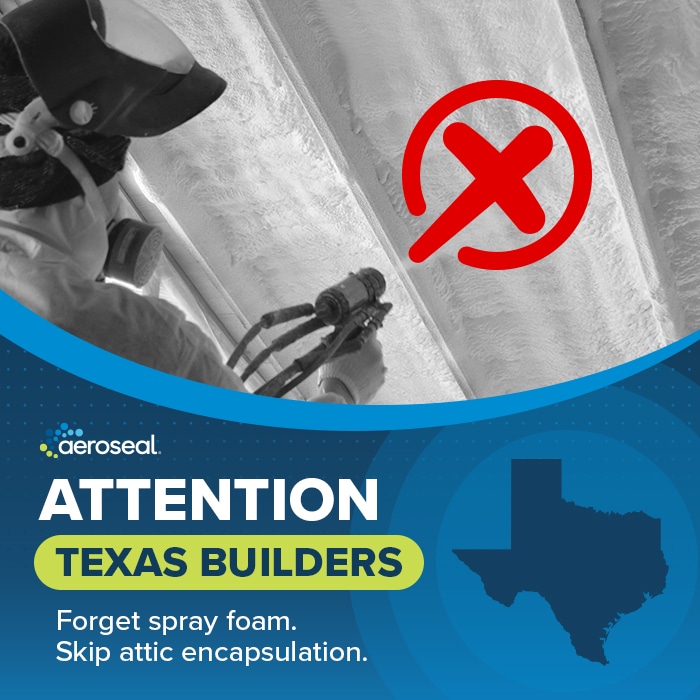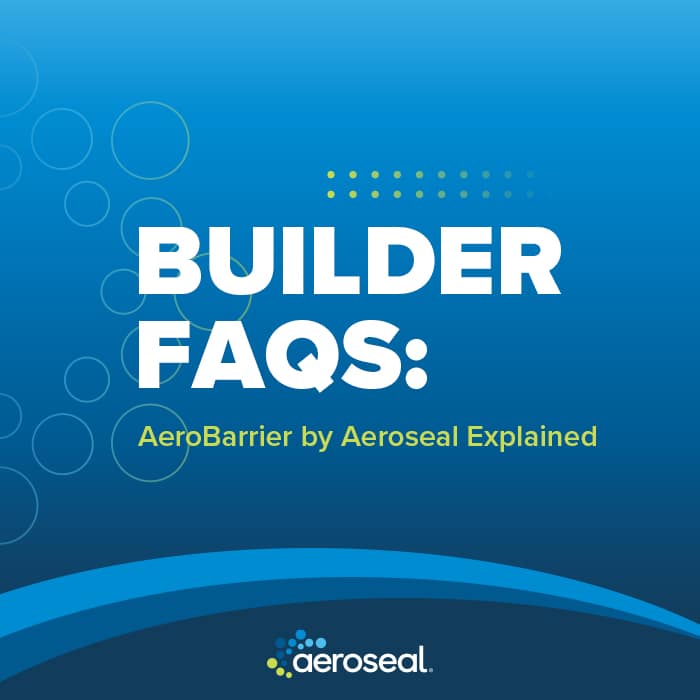How Aeroseal Helps You Meet Building Code Compliance and Performance Standards

If you're a contractor or builder, you know how important building code compliance and performance standards are. It’s not just about checking boxes—it’s about making sure the buildings you create are energy-efficient, comfortable, and safe, and that you can ultimately get your certificate of occupancy. But let’s face it, traditional methods of sealing ducts and building envelopes can be a bit of a headache, and there’s no guarantee that manual sealing will pass the required inspections and tests. That's where Aeroseal comes in, offering a modern solution that's not only more effective but also a lot easier to work with.
Why Building Performance Standards and Codes Matter
Meeting building code compliance can be a bit overwhelming, with different requirements for energy efficiency, indoor air quality, and overall building performance. Here’s the good news: Aeroseal’s duct and envelope-sealing technologies are designed to help you meet code without all the stress. Let's take a look at how Aeroseal lines up with some of the most common codes and standards.
- International Energy Conservation Code (IECC): The IECC is all about making sure buildings don’t waste energy. It has strict rules about how tight your building envelopes need to be. Complicating the matter is the fact that the standards vary from country to country and state to state. So, if you are a builder or contractor that works across different regions, keeping up poses a challenge. Aeroseal makes this easy – our technology can exceed even the strictest standards and measures the leakage while it is sealing. Being able to monitor the leakage while sealing in real-time ensures that you meet code the first time, every time.
- ASHRAE 62.2: This standard is focused on ventilation and indoor air quality and requires that HVAC ductwork be sealed properly to meet the standard. These rates are based on factors like the size of the structure and the number of occupants. Manual methods such as mastic pose a problem because not all leakage can be detected and even those that are may not be completely sealed. There is also the issue of unreachable ductwork in ceilings and walls when buildings are being retrofitted and recommissioned. Because Aeroseal is implemented remotely, traditionally inaccessible leaks are sealed with ease, and small leaks that can be easily missed are found and stopped. This not only guarantees that you meet the standard but also gives building occupants cleaner, healthier air.
- ASHRAE 90.1: ASHRAE 90.1 is a widely adopted standard that sets the minimum energy efficiency requirements for commercial buildings, and it serves as a benchmark for building codes, green building certification programs, and energy efficiency initiatives. The standard covers various aspects of building energy use, including the building envelope, HVAC systems, lighting, and more.
ASHRAE 90.1 requires that ductwork be sealed and tested to minimize leakage. The standard sets maximum allowable leakage rates for ducts, particularly those located outside of conditioned spaces, to ensure that the HVAC system operates efficiently. HVAC systems must also meet specific efficiency ratings, including minimum performance criteria for equipment such as furnaces, air conditioners, and heat pumps. It also mandates that the building envelope be designed to limit air leakage and specifies minimum insulation levels for different climate zones to ensure that the building envelope minimizes heat transfer. Aeroseal can reduce duct leakage by up to 95%, ensuring that the HVAC system operates at its optimal efficiency. This not only helps in meeting the maximum allowable leakage rates specified by ASHRAE 90.1 but also contributes to overall energy savings and improved system performance.
- ENERGY STAR for Homes: Getting an ENERGY STAR certification means your building is top-notch when it comes to energy efficiency. ENERGY STAR-certified homes must have tightly sealed duct systems. Duct leakage to the outside must be less than or equal to 4 CFM per 100 square feet of conditioned floor area at a pressure differential of 25 Pascals. The home must also pass a blower door test with a maximum air leakage rate (e.g., 3 to 5 ACH50, depending on the version of the ENERGY STAR program). Aeroseal helps you hit those high standards of all ENERGY STAR versions, including ENERGY STAR 3.2 by sealing up to 95% of typical duct leakage after manual sealing and can achieve an ACH as low as .5, which is a key part of achieving that coveted certification.
- LEED Certification: LEED is all about green building—reducing energy use, lowering emissions, and improving indoor environmental quality. LEED certification is based on a points system, where buildings earn points for exceeding baseline energy performance requirements (often set by ASHRAE 90.1 or the IECC). Points can also be earned for enhanced indoor air quality, which includes proper duct sealing and minimizing contaminants. Aeroseal contributes to LEED certification by improving energy performance and enhancing indoor environmental quality, both of which are key components of the LEED points system.
- Passive House Standard: This is the gold standard for energy efficiency, requiring buildings to have extremely low energy consumption. The standard is extremely rigorous regarding air tightness. The maximum allowable air leakage rate is 0.6 ACH at 50 Pascals and also requires that the building's total primary energy demand (heating, cooling, hot water, etc.) does not exceed 120 kWh/m²/year. Aeroseal is perfect for meeting these rigorous requirements, helping you create buildings that are extremely airtight and energy-efficient.
- California Title 24: If you’re working in California, you know how tough Title 24 can be. It’s one of the strictest energy codes in the country, with stringent requirements for duct sealing. Duct leakage must not exceed 5% of the system’s total airflow at 25 Pascals pressure differential, or 4 CFM per 100 square feet of conditioned floor area, whichever is less. Aeroseal’s technology is a game-changer here, helping you meet these tough requirements with ease – finding all leaks automatically and monitoring the sealing process to ensure your ductwork is sealed tight.
Aeroseal vs. Traditional Methods: Why Go Modern?
So, how does Aeroseal stack up against traditional methods? Here’s the deal: traditional duct and envelope sealing methods can be a real pain. They’re labor-intensive, prone to errors, and often require a lot of rework to meet today’s strict building codes. Aeroseal, on the other hand, offers a modern approach that’s more effective and efficient, and is quickly becoming the new standard in air sealing.
- Better at Sealing Leaks: Aeroseal’s technology uses aerosolized particles that are carried by the airflow to find and seal leaks. It’s like a GPS for leaks—it finds them and seals them automatically, even the ones in hard-to-reach places. Traditional methods, like using mastic sealant or foil tape, require manual application, which can miss leaks and leave you with a less-than-perfect seal.
- Easier to Apply: With Aeroseal, there’s no need to crawl through tight spaces or tear open walls to access ducts. The process is automated and takes just a few hours, depending on the size of the job. Compare that to traditional methods, which can be time-consuming and labor-intensive, and it’s clear why Aeroseal is the smarter choice.
- More Consistent Results: Because Aeroseal is an automated process, it delivers consistent results every time, and can deliver Controlled Results that meet whatever leakage level the building is designed to. There’s no guesswork, no missed spots, and no wondering if the job was done right. Traditional methods rely on the skill and thoroughness of the installer, which can lead to inconsistent results.
- Quicker Compliance: Meeting building codes can be a race against time, especially on larger projects. Aeroseal speeds up the process, helping you achieve compliance faster and with less hassle. Traditional methods often require multiple passes and extensive testing to ensure they meet today’s strict standards.
- Long-Term Durability: Aeroseal’s seals are durable and long-lasting, designed to stand the test of time. Traditional materials like mastic or tape can deteriorate over time, leading to increased leakage and reduced efficiency.
Wrapping It Up: Why Aeroseal is the Future of Building
At the end of the day, Aeroseal’s duct and envelope sealing technologies offer a better way to meet and exceed building codes and performance standards. They’re more effective, easier to apply, and deliver consistent, reliable results. Whether you’re aiming for ENERGY STAR, LEED certification, or just trying to meet the IECC or Title 24, Aeroseal has you covered.
So, if you’re tired of dealing with the headaches of traditional sealing methods, it’s time to give Aeroseal a try. It’s the modern solution that’s not just better for your projects but also better for your peace of mind.













